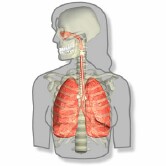
WEDNESDAY, Dec. 31, 2014 (HealthDay News) — Using stem cells derived from a patient’s own bone marrow, researchers have repaired a fistula — a potentially fatal tissue abnormality — in the man’s lower airway.
“This is another interesting new therapeutic approach for stem cells,” said lead researcher Dr. Francesco Petrella, deputy director of thoracic surgery at the European Institute of Oncology in Milan, Italy.
The patient, a 42-year-old firefighter, developed the fistula after surgeons removed a lung as part of treatment for mesothelioma cancer. A fistula is abnormal tissue connecting an organ, blood vessel or intestine to another structure. In this case, the fistula developed between the lower airway and the tissue that surrounds the lungs.
“Our clinical experience supports the idea that stem cells could be effectively used to close some tissue defects developing after very complex surgical procedures, thus restoring a functioning airway,” Petrella said.
A fistula that develops after chest surgery is serious and even deadly, Petrella said. Current treatments involve removing ribs and taking medications for months or years, he explained.
“Less invasive approaches like endoscopic glue injections have only poor results, so our proposed techniques could improve quality of life in these patients,” Petrella said.
Sixty days after stem cell therapy, the firefighter’s fistula was healed, the researchers said. The hole seen before stem cell therapy was no longer visible, having been replaced by new tissue created by the stem cell implant, they explained.
Some people are born with a fistula. Other causes of fistulas include complications from surgery, injury, infection and diseases, such as Crohn’s disease or ulcerative colitis.
Petrella believes that this same stem cell technique could be used to treat fistulas that develop elsewhere in the body.
“For example, I think it could be used to treat fistulas in the esophagus as well as in the stomach or colon, and fistulas that connect the lower portion of the large intestine with the rectum and vagina,” he said.
Petrella describes the process in the Jan. 1 issue of the New England Journal of Medicine.
Mariano Garcia-Arranz, a senior researcher at the Health Research Institute Foundation Jimenez Diaz in Madrid, Spain, said the article confirms the effectiveness of stem cells in the treatment of fistulas.
But the type of fistula treated in this study is very rare, he said, adding that more study is needed before stem cells are routinely used as a treatment.
“However, so far, all cases that have been treated with stem cells have been successful,” he said.
More information
For more about fistulas, visit the U.S. National Library of Medicine.
Copyright © 2025 HealthDay. All rights reserved.

